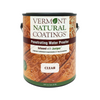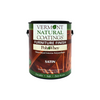
Non-Toxic Wood Sealing: A Definitive Guide
Decorating your home with wood is one of the best ways to add a natural aesthetic to your home's interior and exterior. When harvested in an environmentally friendly manner, wood is one of the most environmentally friendly building materials available. Sustainably managed and harvested forests are a vital ecosystem and can capture enormous amounts of excess carbon dioxide in our atmosphere. When cared for properly, wooden flooring, furniture, countertops, etc., can last for a lifetime and thus "lock up" that carbon for decades or centuries. You can check out this helpful Rise guide for more detailed information on sourcing wood products certified by sustainable forestry programs.
What many homeowners don't realize, however, is that the vast majority of wood products in our homes are essentially "soaked" in several different chemicals that could pose a serious risk to our health and wellbeing. One recent study found that around 80 percent of current wood finishes contain some sort of toxic volatile organic compounds (VOCs). Commonly used solvents like turpentine and paint thinner have been shown to off-gas up to 60 different chemicals. Many of these chemicals are known or suspected carcinogens, and others have been linked to developmental and hormonal risks for children and pregnant women.
This complete Rise guide looks at how homeowners can seal, stain, and protect the wood in their home's interiors and exteriors without turning their home into a chemical laboratory.
Table of Contents
- What Will Happen if I Leave Wood Untreated?
- What Does Waterproofing Wood Do?
- Can You Seal Fresh-Cut Wood?
- Can All Woods Be Sealed?
- Does Sealing Wood Change the Color?
- How Do You Prepare Wood for Sealing?
- How Do You Apply Wood Sealer?
- How Long Does Wood Waterproofing Last?
- How Much Does Wood Sealer Cost?
- What’s the Best Waterproofing for Wood?
What Will Happen if I Leave Wood Untreated?
Before we jump into the best non-toxic wood sealing alternatives, it is important to note that deciding not to seal or treat the wood in your home is also not the best option. Wood that is not properly treated or sealed will generally not be nearly as durable or permanent. When wood is not sealed or protected with a protective coating of polyurethane, urethane, sealants, or some other type of coating, it readily absorbs liquid and moistures. A spilled drink on your wood floor, driving rains that hit your wood siding, and even high humidity inside and outside your home can cause the wood to swell, thus leading to warps, cracks, and other imperfections.
Furthermore, untreated wood is much more prone to be "infested" by termites, bugs, mildew, mold, and other "pests" that can quickly ruin your wood interior or exterior.

Related Products
Shop Related Products
Vermont Natural Coatings Penetrating Water Proofer Infused With Juniper
$28.75 - $398.00
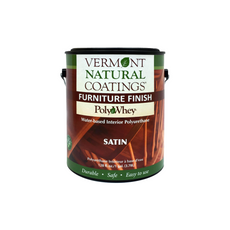
Vermont Natural Coatings PolyWhey Furniture Finish
$29.75 - $416.75
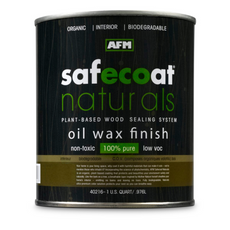
AFM Naturals Oil Wax Finish
$45.00 - $570.00
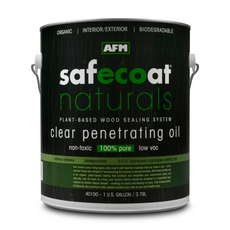
AFM Naturals Clear Penetrating Oil
$39.00 - $530.00
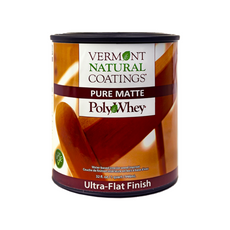
Vermont Natural Coatings Pure Matte Finish (Ultra Matte) with PolyWhey
$36.00 - $521.00
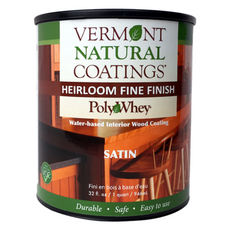
Vermont Natural Coatings Heirloom Fine Finish
$31.00
What Does Waterproofing Wood Do?
Waterproofing your wood is the most straightforward way to protect wood against rot, moisture, mold, and mildew. Though there are other natural ways to protect your wood from moisture (check out this Rise article on the Japanese Shou Sugi Ban method), most people rely on varnishes, sealants, and other similar products that are applied to the surface of the dry wood. Any wood that is exposed to sunlight, rain, or excessive moisture should be waterproofed as this can help to prevent:
- Cracks
- Warping
- Splitting
- Discoloration
- Wear and premature breakdown,
- Mold, termite, and other pest infiltration.
Waterproofing wood not only protects the wood from moisture (as its name implies) but also plays an essential role in protecting it from long-term exposure to the sun's UV rays.
Can You Seal Fresh-Cut Wood?
Before treating wood with any sealant or waterproofing agent, it is important to ensure that the wood is completely dried out. Wet wood, also called green wood, will continue to shrink as it loses water, which can negatively affect the sealant. Fortunately, the vast majority of wood products you purchase from lumber yards, home improvement stores, and other similar commercial venues will have already dried. If you are harvesting the wood on your property, allow the wood to dry properly before sanding and sealing the wood.

Can All Woods Be Sealed?
Today, homeowners can choose from several different types of exotic wood products that offer an incredibly exotic touch to their homes. In general, exotic wood species tend to be much "denser" than the typical pine and other softwoods that are often sold at lumber yards across North America.
Wood sealant works by penetrating the wood fibers, thus creating a thin film on the surface of the wood. Because of the density of exotic woods, it can be significantly more challenging for the sealant to penetrate these pores. In some cases, you might not need to seal exotic woods, especially for interiors where they will not be exposed to regular moisture or excessive traffic.
If you want to seal your exotic wood, you should never use oil-based sealants, including polyurethane, the most common type of wood sealant used. Oil-based sealants don't work well with many kinds of exotic wood because the chemical reaction that oil-based sealants cause in standard wood types does not happen with exotic wood types. Furthermore, clear sealants are usually preferred with exotic woods as they allow the natural textures, grains, and hues of the exotic wood to shine through.
Instead of using oil-based polyurethane sealants, consider using a few coats of de-waxed shellacs before putting on a top coat.
Does Sealing Wood Change the Color?
When choosing the best wood sealant for your home, one of the first decisions you will need to make is whether you want a tinted or clear sealant. Today, homeowners can choose from several different wood sealant products that include stains or pigmentation. On the plus side, pigmented sealants allow you to "feed two birds with one hand" by staining and sealing the wood all at once. However, if you prefer the natural look of the wood, you can opt for clear sealant products. However, it is important to point out that wood finishes of any type, including polyurethane, shellac, lacquer, wax, and varnish, will always alter the wood's appearance by accentuating the grain and texture of the wood. In general, sealants will also darken and deepen the natural color of the wood. If you want to avoid that glossy, shiny, amber-golden look, then it is probably not a good idea to opt for oil-based polyurethane sealants or finishes.
How Do You Prepare Wood for Sealing?
To prepare wood for sealing, here is a quick checklist to help you along the process:
- Check the moisture content of the wood: Trying to seal wet wood is a recipe for failure, as the sealant will not properly adhere to the wood. Exterior wood surfaces should not have more than 15-20 percent moisture, while interior wood should be between 12-15 percent. You can purchase a moisture meter if you are unsure if your wood is too wet.
- Seal all knots: If you are working with bare wood, you should prime all the knots with a shellac-based primer.
- Fill in the cracks: Use a high-grade interior or exterior grade wood filler to seal any visible cracks or holes in the wood.
- Sand the wood: Lastly, use 150g – 220g of sandpaper and sand in the direction of the wood grain. Going against the grain could lead to scratches that absorb your stain or sealant unevenly.

How Do You Apply Wood Sealer?
Once you have prepared your wood, following the steps outlined above, you will be ready to apply the sealant. Use high-quality brushes or rollers. If you are working with water-based polyurethane, do not stir too harshly, as this could lead to bubbles. Also, do not put more sealant on the brush than necessary, and do firm, long strokes following the wood grain. Never apply a second coating or paint over the same area until it completely dries.
How Long Does Wood Waterproofing Last?
When applied correctly, a quality sealant should last for several years. This, of course, depends on the type of wood you are sealing, the product you are using, where the wood is located, and how exposed the wood is to the elements. Wood that receives direct sunlight for long hours of the day will generally need to be re-waterproofed regularly as the UV rays will cause the sealant to degenerate over time. Similarly, exterior wood exposed to direct rain or moisture will also need regular maintenance and extra coatings. You should expect the sealant to last for at least 10-15 years for interior wood that doesn't receive heavy foot traffic.
How Much Does Wood Sealer Cost?
The exact cost of wood sealant will depend on the product's quality. Though it is possible to find relatively cheap wood sealants for sale on the market, these products will generally be less durable and may off-gas dangerous VOCs into your home. For comparison's sake, a 5-gallon bucket of AFM Naturals Oil Wax Finish costs $570 here at Rise.
What’s the Best Waterproofing for Wood?
Fortunately, several non-toxic wood sealant products are on the market today. Below, we briefly review the top three products for non-toxic wood sealing.

Vermont Natural Coatings
This innovative company uses a patented formula that harnesses the power of whey protein, a byproduct of cheese making, and uses these proteins to replace the toxic ingredients traditionally found in wood finish. Their Penetrating Water Proofer is a natural wood preservative product that seals the wood from the inside, extending the life of the wood by controlling moisture, thus reducing mold and decay. The waterproofer uses Juniper as a powerful natural wood preservative. The result is a long-lasting, zero VOC waterproofer that is safe for people, pets, and the environment.

AFM Safecoat
This company uses natural mineral pigments instead of dyes and no formaldehyde or other toxic ingredients. The strong and durable finish has no harsh solvents, fumes, or odors. AFM Naturals™ Oil Wax Finish is a plant-based hardener and sealer for wood, bamboo, and cork flooring. It can also be used on other wood surfaces, including children's toys and furniture.

Zinsser's Shellac Sealcoat
Zinsser offers a great shellac-based wood sealant. Shellac is a substance that comes from insects but acts as a safe wood sealant. Shellac is not a great option for the kitchen as it does not stand up to alcohol.
No matter what type of wood sealant option, finding a natural sealant is the best way to drastically reduce the dangerous VOC emissions off-gassing into your home.
Disclaimer: This article does not constitute a product endorsement however Rise does reserve the right to recommend relevant products based on the articles content to provide a more comprehensive experience for the reader.Last Modified: 2023-02-09T16:48:38+0000Article by:
Tobias Roberts
Tobias runs an agroecology farm and a natural building collective in the mountains of El Salvador. He specializes in earthen construction methods and uses permaculture design methods to integrate structures into the sustainability of the landscape.
